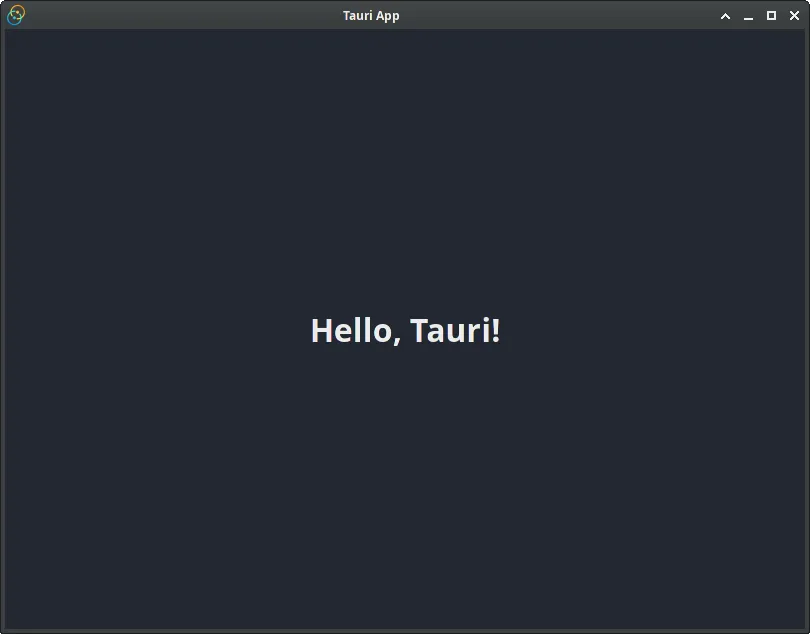設定
此範例應用程式僅專注於將 WebDriver 測試新增至現有專案。為了在接下來的兩個章節中有一個專案可以測試,我們將設定一個極簡的 Tauri 應用程式以用於我們的測試。我們將不使用 Tauri CLI、任何前端依賴項或建置步驟,也不會在之後捆綁應用程式。這是為了展示一個極簡的套件,以展示將 WebDriver 測試新增至現有應用程式。
如果您只想查看完成的範例專案,其中使用了本範例指南中將展示的內容,那麼您可以查看 https://github.com/chippers/hello_tauri。
初始化 Cargo 專案
我們想要建立一個新的二進制 Cargo 專案來存放此範例應用程式。我們可以從命令列使用 cargo new hello-tauri-webdriver --bin 輕鬆完成此操作,這將為我們搭建一個最小的二進制 Cargo 專案。此目錄將作為本指南其餘部分的工作目錄,因此請確保您執行的命令位於這個新的 hello-tauri-webdriver/ 目錄內。
建立最小前端
我們將建立一個最小的 HTML 檔案,以作為我們的範例應用程式的前端。我們稍後也將在我們的 WebDriver 測試中使用此前端中的一些內容。
首先,讓我們建立我們的 Tauri distDir,我們知道在建置應用程式的 Tauri 部分後,我們將需要它。mkdir dist 應該建立一個名為 dist/ 的新目錄,我們將在其中放置以下 index.html 檔案。
dist/index.html:
<!doctype html><html lang="en"> <head> <meta charset="UTF-8" /> <title>Hello Tauri!</title> <style> body { /* Add a nice colorscheme */ background-color: #222831; color: #ececec;
/* Make the body the exact size of the window */ margin: 0; height: 100vh; width: 100vw;
/* Vertically and horizontally center children of the body tag */ display: flex; justify-content: center; align-items: center; } </style> </head> <body> <h1>Hello, Tauri!</h1> </body></html>將 Tauri 新增至 Cargo 專案
接下來,我們將新增必要的項目,將我們的 Cargo 專案變成 Tauri 專案。首先,是將依賴項新增至 Cargo Manifest (Cargo.toml),以便 Cargo 知道在建置時拉取我們的依賴項。
Cargo.toml:
[package]name = "hello-tauri-webdriver"version = "0.1.0"edition = "2021"rust-version = "1.56"
# Needed to set up some things for Tauri at build time[build-dependencies]tauri-build = "1"
# The actual Tauri dependency, along with `custom-protocol` to serve the pages.[dependencies]tauri = { version = "1", features = ["custom-protocol"] }
# Make --release build a binary that is small (opt-level = "s") and fast (lto = true).# This is completely optional, but shows that testing the application as close to the# typical release settings is possible. Note: this will slow down compilation.[profile.release]incremental = falsecodegen-units = 1panic = "abort"opt-level = "s"lto = true您可能已經注意到,我們新增了 [build-dependency]。若要使用建置依賴項,我們必須從建置腳本中使用它。我們現在將在 build.rs 建立一個。
build.rs:
fn main() { // Only watch the `dist/` directory for recompiling, preventing unnecessary // changes when we change files in other project subdirectories. println!("cargo:rerun-if-changed=dist");
// Run the Tauri build-time helpers tauri_build::build()}我們的 Cargo 專案現在知道如何使用所有這些設定來拉取和建置我們的 Tauri 依賴項。讓我們透過在實際專案程式碼中設定 Tauri 來完成這個最小的範例,使其成為 Tauri 應用程式。我們將編輯 src/main.rs 檔案以新增此 Tauri 功能。
src/main.rs:
fn main() { tauri::Builder::default() .run(tauri::generate_context!()) .expect("unable to run Tauri application");}非常簡單,對吧?
Tauri 組態
我們將需要 2 件事才能成功建置應用程式。首先,我們需要一個圖示檔案。您可以使用任何 PNG 作為下一個部分,並將其複製到 icon.png。通常,當您使用 Tauri CLI 建立專案時,這將作為搭建的一部分提供。若要取得預設的 Tauri 圖示,我們可以使用命令 curl -L "https://github.com/chippers/hello_tauri/raw/main/icon.png" --output icon.png 下載 Hello Tauri 範例儲存庫使用的圖示。
我們將需要一個 tauri.conf.json 來設定 Tauri 的一些重要組態值。同樣,這通常來自 tauri init 搭建命令,但我們將在此處建立我們自己的最小組態。
tauri.conf.json:
{ "build": { "distDir": "dist" }, "tauri": { "bundle": { "identifier": "studio.tauri.hello_tauri_webdriver", "icon": ["icon.png"] }, "allowlist": { "all": false }, "windows": [ { "width": 800, "height": 600, "resizable": true, "fullscreen": false } ] }}我將說明其中一些。您可以看到我們稍早建立的 dist/ 目錄指定為 distDir 屬性。我們設定了一個捆綁包識別碼,以便建置的應用程式具有唯一的 ID,並將 icon.png 設定為唯一的圖示。我們沒有使用任何 Tauri API 或功能,因此我們透過將 "all": false 設定在 allowlist 中來停用它們。視窗值僅設定要建立的單個視窗以及一些合理的預設值。
此時,我們有一個基本的 Hello World 應用程式,執行時應顯示簡單的問候語。
執行範例應用程式
為了確保我們做得正確,讓我們建置這個應用程式!我們將以 --release 應用程式的形式執行它,因為我們也將使用發布設定檔執行我們的 WebDriver 測試。執行 cargo run --release,在一些編譯之後,我們應該會看到以下應用程式彈出。

注意:如果您正在修改應用程式並想要使用開發者工具,請在不使用 --release 的情況下執行它,並且「檢查元素」應該在右鍵選單中可用。
我們現在應該準備好開始使用一些 WebDriver 框架測試此應用程式。本指南將依序介紹 WebdriverIO 和 Selenium。
© 2025 Tauri 貢獻者。CC-BY / MIT